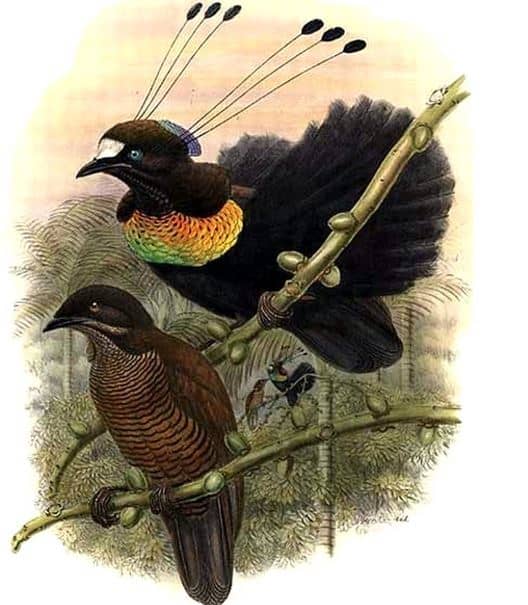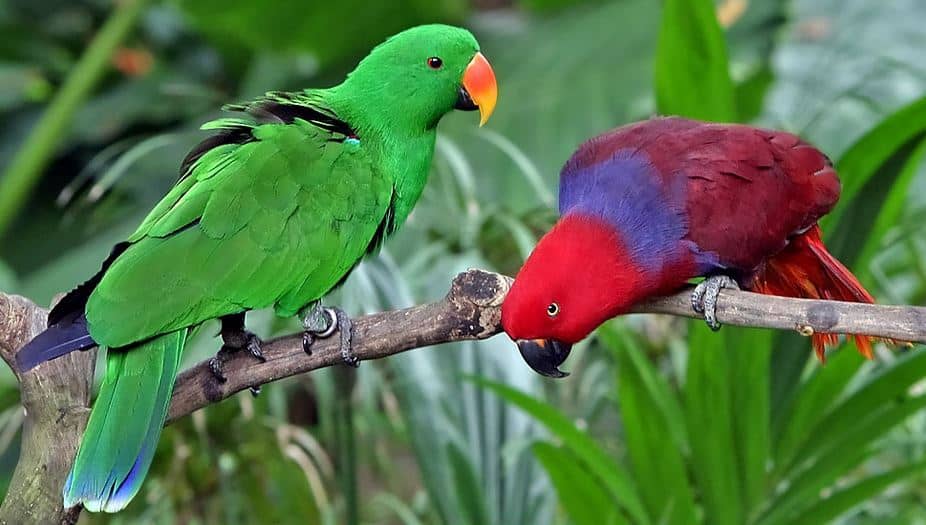In the bird world, the males tend to have the brighter feathers. So it is understandable that experts have suggested that evolution has made them more and more colourful and the females plainer and plainer, but in general the opposite has occurred.
Over time, birds’ plumages (male vs. female) have overall become more similar, and what evolution focuses more on, as far as colour is concerned, is predation and foraging success, say researchers at the University of Wisconsin-Milwaukee.
Their findings have been published in the academic journal Science Advances (citation below).
Ever since Charles Darwin in the 19th century, researchers have focused on the difference between the sexes in the world of birds, attributing the males’ brighter colors to their need to attract females.

Two Birds of Pardise, a male (top) and a female. (Image: rspb.royalsocietypublishing.org)
Professors of biological sciences at UW-Milwaukee, Linda Whittingham and Peter Dunn, and former UW-Milwaukee graduate student Jessica Armenta, who now teaches at Austin Community College in Texas, took a different approach.
Evolution also brought similarities
They tested a hypothesis that evolution has actually resulted in similarities in male and female birds as much as differences.
The researchers looked at 977 species of birds, and found that while males have brighter colours, the two sexes’ markings have come closer together over time to blend into the surroundings and hide from predators.
Natural selection – during migration, breeding in subtropical habitats and caring for young – is as powerful as sexual selection, they found.
The authors wrote:
“Although most studies of bird plumage focus on dichromatism, evolutionary change has most often led to similar, rather than different, plumage in males and females.”
“Our study shows that ecology and behavior are driving the color of both sexes, and it is not due to sexual selection.”
Ms. Armenta spent four years gathering and analyzing data from 977 species of birds from six museums in the United States and Australia. She looked at six birds of each species, three females and three males.
Professors Whittingham and Dunn analyzed the data. They assigned each bird a colour score based on the scales of brightness and hue. Plumage colour was examined in relation to 10 measures of sexual and natural selection.
Dunn and Whittingham wrote:
“Researchers have called for separate analyses of each sex for over a decade, but this is the first large-scale study to examine the color of each sex in relation to indices of both natural and sexual selection.”

The female Eclectus Parrot (right) is as colourful (perhaps more so) than the male. (Image: Wikimedia)
Natural versus sexual selection
In the cases where sexes became more similar in colour, this occurred for reasons of natural selection. When the colour difference increased, it had more to do with sexual selection, they found.
Prof. Dunn hopes their findings will send future researchers in new directions.
Prof. Dunn said:
“A lot of research has focused on how plumage color is related to mating success, especially in males. So this should hopefully get researchers to think more about how color affects survival, especially predation and foraging success, in both sexes.”
Bird colours and number of mates
They were surprised to find that male birds with multiple mates tend to have duller colours compared to their female counterparts.
For example, male red-winged blackbirds, which can have up to a dozen mates, are less colourful than the females.
Prof. Dunn says:
“The reason for this is that males in these species often have a lot of black plumage.”
Citation: “Natural and sexual selection act on different axes of variation in avian plumage color,” Peter O. Dunn, Jessica K. Armenta and Linda A. Whittingham. Science Advances. Published 27 March, 2015. DOI: 10.1126/sciadv.1400155.

